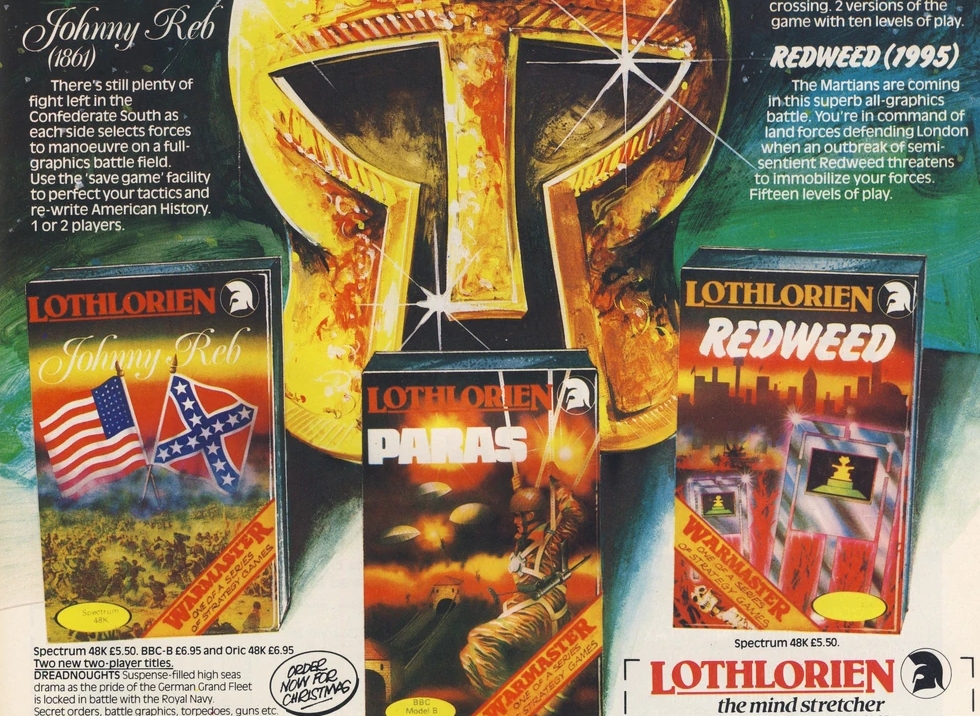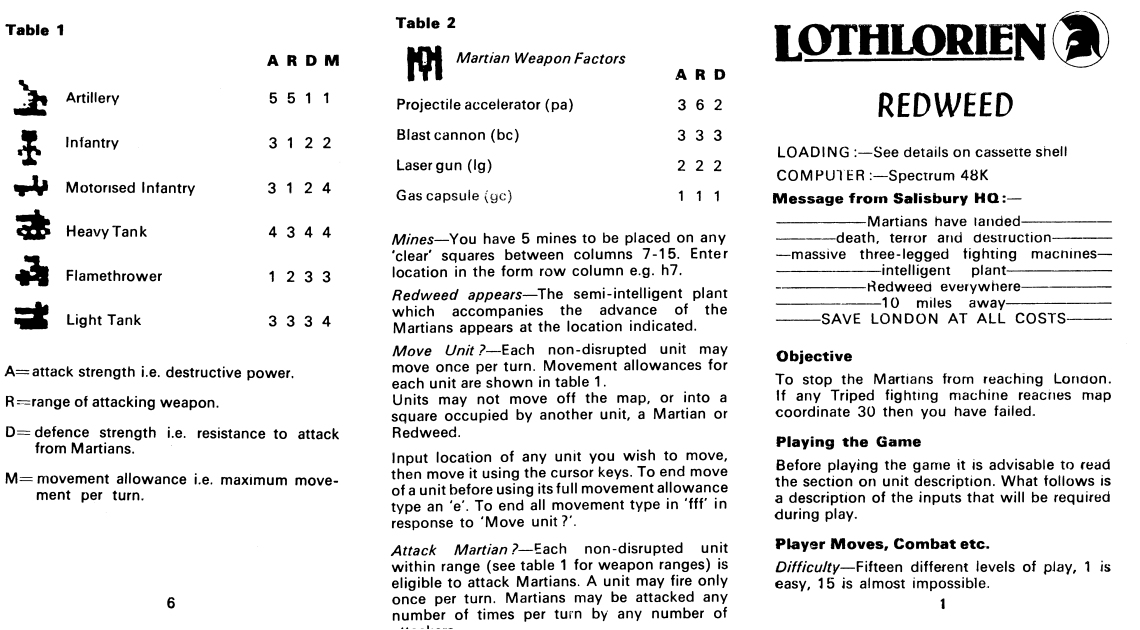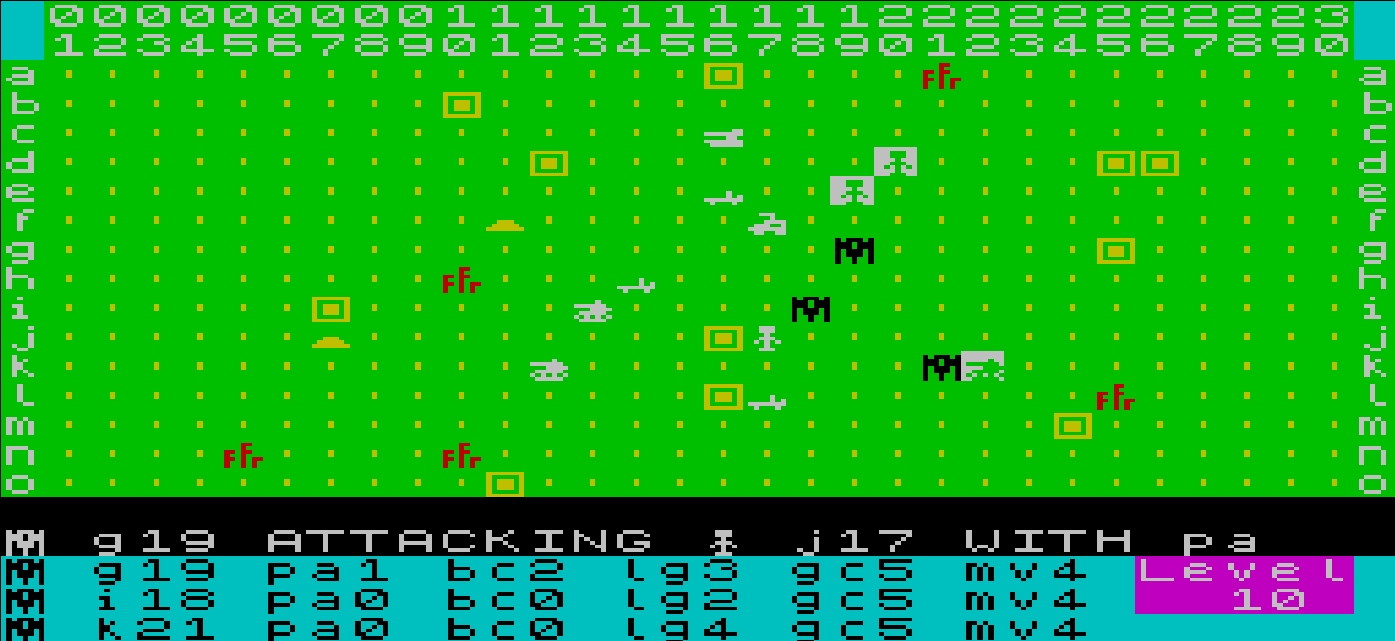In early Eighties Britain, one of the disadvantages of expanding your video game collection via mixtapes exchanged in rambunctious school playgrounds was also one of the advantages. Because that C60 you were stuffing into the pocket of your parka had been compiled by your mate’s cousin’s neighbour’s uncle, you had no real idea what you were getting until you compared the titles scrawled on the sleeve to the adverts printed in the pages of your favourite ZX Spectrum magazine.

While Memorex, the mixtape deity, was kind enough to furnish my juvenile self with a number of wargames and sims, he never got around to introducing me to the wares of Lothlorien. Looking back, that’s a pity, because I reckon I’d have relished titles like Waterloo, Johnny Reb, and Redweed.

Although Redweed’s unit control system feels horribly dated today (The player selects units by typing in map coordinates, then moves them about with laggy cursor key presses), the game’s premise and action have lost little freshness and appeal during the past four decades.
Once a delightful animated title screen has reminded you just how huge and formidable the London-bound Martian ‘tripeds’ are, you’re whisked straight to an anonymous rectangle of SE England and asked to select one of fifteen difficulty levels. Considerate Lothlorien uphold the Difficulty Compact perfectly. While a Level 1 commander must stop the same number of tripeds as a Level 15 commander (three), their task is much easier because foes at lower difficulty settings are less mobile and carry fewer weapons.

One of the main reasons Redweed still feels novel in 2024 is that profoundly asymmetric wargames like this are still awfully rare creatures. In their most intimidating form the game’s murderous milking stools can travel five squares per turn, and tote two projectile accelerators, two blast cannons, four lasers, and five gas dispensers apiece. As every weapon doubles as a hit point, and no player attack can deal more than 1 HP of damage, stopping Level 15’s striding colossi before they reach column 30 (the object of the game) is nigh-on impossible. Happily, players who opt for sub-7 difficulty aren’t necessarily on a hiding to nothing. Aim low (but not too low) and you’re guaranteed a tense hour or two of action-packed WEGO wargaming.

Influenced by the position of defence-boosting town squares and the locations of five landmines handplaced at the start of a game, player tactics are mainly driven by the strengths and weaknesses of the six friendly unit types, and the behaviour and condition of the eastbound Martians. The fact that the player can target individual triped weapons, means a skilled/lucky commander can, in theory, de-claw a foe at distance using tanks and big guns. Once a triped has lost its projectile accelerators, its reach is equivalent to the best British AFVs, and shorter than your slow-moving arty.
The snag is the Martians don’t sit around waiting to be whittled down, and unless you get stuck-in – unless you slow their progress with a few sacrificial speed-bumps – they’re sure to reach their goal before cautious attrition brings them to a halt.

Disappointingly, the crimson vegetation referenced in the title and depicted on the cassette cover rarely impacts decision-making. Capable of disabling human units that get too close, and only vulnerable to flamethrowers, weed sprouts at a rate of one square per turn in pre-scripted locations and never spreads, meaning it’s a trivial annoyance at best.
In the Redweed remake I’ve been mentally coding over the last couple of days, the titular ground cover spreads naturalistically from unpredictable spawnpoints. If not tackled it makes swathes of randomly generated, forest-dotted, river-riven maps impassable to human forces. Once set ablaze, for a time, it produces LoS-disrupting, wind-wafted smoke.

Altered and embellished in these and other carefully considered ways (I’d be tempted to swap squares for hexes and add unit repair too) I reckon Redweed could entangle modern wargamers every bit as efficiently as it entangled Eighties ones.


Ah you were one of the cool kids at school with a ZX Spectrum? I was stuck with a BBC B so i ‘could make my own games’… Strangely one of the rare occasions where parents were actually correct.
I did borrow my friend’s Spectrum a few times to play Desert Rats, Vulcan and Encyclopaedia of War: Ancient Battles (An early Field of Glory).
When he wasn’t so forthcoming, my go to games were Millionaire, Twin Kingdom Valley, Sink the Bismarck and Tanks (The wargame not the side shooter) :).
It looks as though Lothlorien probably wrote their games in ZX BASIC rather than machine code, so a straight port might well be quite straightforward!
Confirmed: It’s not only in BASIC, the code’s even commented!
Didn’t the BBC-US co-production(?) of ‘The Tripods’ come out about the same time? Might be why they felt they needed some distinction.
First entry in the “Dusty and, well, Musty” series?
When people complain today about dishonest trailers and developers broken ‘promises’, I think back to these early days of computing, when box-art for a game was so far away from what the game actually looked like, it was more of a ‘mood piece’ to fire your imagination.
Take the top shot above. If you didn’t know which game Tim was playing, could you pick out the correct cover based on the screenshot?
Tim, I was just wondering whether you are now actually trying to remake this game? If not, I might consider having a crack at it, would make a great little GameMaker Studio project, I think.
As it happens, I am!
What started off as a straight remake is rapidly morphing into something more complicated/ sophisticated.
https://tallyhocorner.com/wp-content/uploads/2024/11/redweedteaser.jpg
RW2 will feature faux hexes, new terrain and unit types, a random map generator, and completely reworked combat mechanics. It will probably wind up on my huge ‘unfinished projects’ pile but you never know.
Wonderful! I look forward to playing it if / when it is completed.
These old games have very rudimentary graphics, but many have very innovative game play, and highly immersive themes, particularly in a sci-fi context. Gameplay and theme trump graphics, in my opinion.